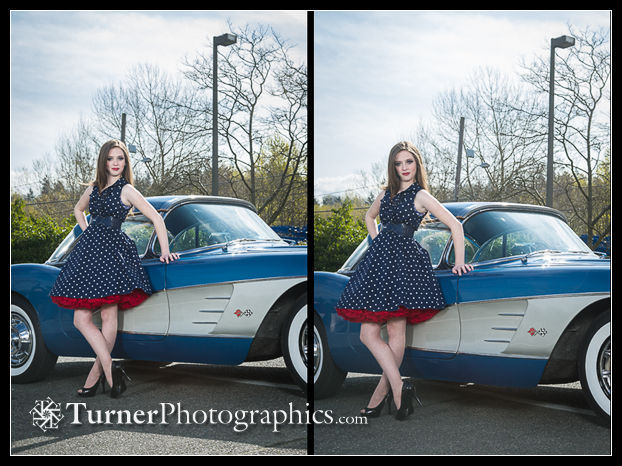Digital Photo Tip: Clean Up the Frame
Little details matter when you want to set your pictures apart from the masses. You don’t want anything to intrude into the frame that shouldn’t be there. Your viewer’s attention should go to whatever it is you’re photographing, without distracting stuff getting in the way. I call it “cleaning up the frame.” Here are five ways to clean up your photos before you press the shutter button.
What’s that growing out of your head?

Note the pole coming from the model’s head in the photo on the left. Moving the camera to the right fixed the problem.
Watch for objects like telephone poles, trees, or lampshades growing out of people’s heads. It’s usually pretty easy to move over a little, or ask your subject to move, to fix the problem. I have a snapshot of myself and some climbing buddies commemorating our climb to the top of Devil’s Tower in Wyoming many years ago. I handed my camera to another climber and our party posed around the post marking the summit. I failed to realize that when I sat with my back to the post the spike came out of the top of my head. It would have been a better photo if we’d grouped ourselves with the post between two of us.
Power away from the lines
![1103493 California Buckeye shrub & tree forms [Aesculus californica]. CA 36, Paynes Creek, CA. © Mark Turner California Buckeye](/wp-content/uploads/2015/02/Turner_1103493.jpg)
![1103493 California Buckeye shrub & tree forms [Aesculus californica]. CA 36, Paynes Creek, CA. © Mark Turner California Buckeye](/wp-content/uploads/2015/02/Turner_1103493-2.jpg)
Power lines, telephone wires, and their supporting poles are critical to our modern way of life. But they’re usually pretty ugly in a photograph. Often you can simply walk closer to your subject to keep the wires out of your frame. There’s a trade-off, though: you’ll likely have to zoom out. That can lead to distortion, especially when photographing buildings. To get rid of poles, or minimize them, try moving to one side or the other from your original camera position. A pole on the side of the frame is much less distracting than one jutting up into the middle.
What’s that BSO?
![1400660 Bigleaf Maple [Acer macrophyllum]. Natalie McClendon, Bellingham, WA. © Mark Turner Cottonwood buds](/wp-content/uploads/2015/02/Turner_1400654-1400659.jpg)
Removing the bright horizontal branch at the top of the frame cleans up the background.
A BSO is a Bright Shiny Object, which can really be any bright spot in the background of a photograph that distracts attention away from the subject. I spend a lot of time cleaning up BSOs in my garden and native plant photography. It could be a piece of white gravel, a leaf that’s reflecting the light just so, a piece of dry grass, or water droplets catching the sun. Since my camera is usually on a tripod I can check the frame for bright distractions and pick them out. The goal isn’t to make the photograph flat and dull, but to remove the worst and biggest of the distractions. Depth of field preview helps you see the problems because a very blurred bright thing in the background isn’t as distracting as the same object when it’s sharper.
Don’t poke me
![1205979 Sitka Willow female catkin & foliage detail against blue sky [Salix sitchensis]. Mt. Baker-Snoqualmie NF Heliotrope Ridge Tr, Deming, WA. © Mark Turner Sitka Willow](/wp-content/uploads/2015/02/Turner_1205979-1205981.jpg)
Moving the camera a little closer and to the right eliminated the distracting bits at the top corner and left side of the frame.
While branches and leaves can make a nice frame around your subject, setting up a very desirable foreground-background relationship, try to avoid bits of stuff randomly sticking into the edge of your photo. If you’re shooting a nature close-up you can often bend the offender out of the way. For wider scenes, change your camera position to crop out the offender. Consider moving up or down, left or right, closer or farther. Often a few inches is all the change that’s necessary.
Gimme space to breathe
![1205502 Wiggins' Lily blossom [Lilium pardalinum ssp. wigginsii]. Takilma-Happy Camp Rd, Cave Junction, OR. © Mark Turner Wiggins' Lily](/wp-content/uploads/2015/02/Turner_1205502.jpg)
Be careful of objects touching the edge of the frame, or nearly so. I find I have to pay more attention to this with plant portraits and flower details than when photographing people. When the tip of a petal, for example, touches the edge of the frame it creates visual tension that attracts the eye. Back off or reframe to leave a little space between the object and the edge of your photograph. Or go a little closer and make it obvious that you deliberately cut the object off with the frame line.
Some of these problems with distractions can be fixed later on your computer, but it’s almost always faster and easier to fix them before you shoot. Take a moment while you’re composing your shot to look carefully at all four edges of the frame, to check for bright stuff in the background, and to think about whether there’s anything there that doesn’t belong. Make it a habit, and your photos will be better.

